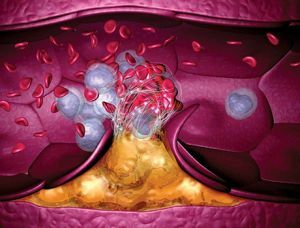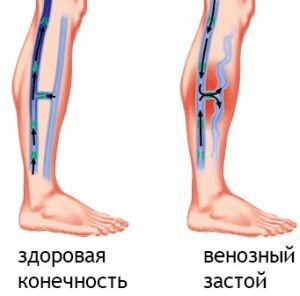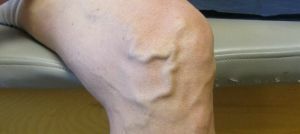 Under hyperemia, is understood as enhancing the filling of blood vessels, tissues, and organs with .
Under hyperemia, is understood as enhancing the filling of blood vessels, tissues, and organs with .
This appears due to an excess of arterial blood flow, initiated by a violation of the outflow of venous blood.
Hyperemia happens arterial and venous:
- Arterial hyperemia implies increased blood flow in the arteries due to a sudden increase or decrease in vascular tone. Vessels and arteries expand, so blood moves faster and in larger quantities.
- Venous hyperemia is characterized by a violation of blood flow in the veins, which appears due to compression of the vein wall or a decrease in cardiac performance.
Contents
- Causes of venous hyperaemia
- Pathogenesis and mechanism of development of pathology
- Signs of the disease
- Diagnostic techniques
- How is venous hyperemia treated?
- Consequences of venous hyperemia
Causes of venous hyperemia
Different types of venous hyperemia are based on different causes.
As a rule, the cause of venous hyperemia can become blockage of a vein thrombus with thin walls , squeezing them from the outside with inflammatory edema, swelling or scar and other factors.
Hyperemia in small pelvic vessels promotes compression of veins in this part by a tumor of the uterus or during pregnancy.
Venous hyperemia may be associated with the pathology of the constitution: a mild development of elastic or smooth muscle elements of the wall of venous vessels.
Such people, in addition to varicose veins, tend to develop a hernia, hemorrhoids and other diseases. Insufficiency of the elastic tissue is observed in those who most of the time working standing or lifting weights, as well as with a sedentary lifestyle.
A common cause of venous congestion is a violation of the suction function of the right ventricle of the heart if the heart is broken.
 And yet, what is Varifort's deception or truth? Our specialists investigated this issue in detail.
And yet, what is Varifort's deception or truth? Our specialists investigated this issue in detail. How dangerous is thrombophilia in pregnancy and what possibilities does modern medicine offer for successful bearing of a child? Also in the article about risk factors and causes of pathology.
Pathogenesis and mechanism of pathology development
The pathogenesis of venous hyperemia is caused by such factors:
- with reduced arterio-venous pressure;

- venous occlusion( thrombosis or embolism);
- by decreasing the elasticity of the venous walls;
- by the difficult movement of venous blood due to its thickening and viscosity increase;
- by squeezing the veins with an outflow, swelling, etc.;
- violation of cardiac performance;
- decreased suction function of the chest due to accumulated blood, or air in the pleural plane.
So, let's repeat that the mechanism of development of venous hyperemia - is:
- compression of veins by external factors - tumor, scars, uterus during pregnancy, surgical bandaging of vessels;
- compression of veins by edematous fluids;
- venous thrombus occlusion.
Symptoms of the disease
There are such symptoms of venous hyperemia:
- lowering the temperature of the tissue or organ in the area of venous stasis;
- cyanosis( cyanosis) of the skin and mucous membranes as a result of filling the surface vessels with blood, which contains reduced hemoglobin;
- cyanosis is more evident on lips, nose, fingertips;
- slowing and stopping blood flow in microvessels;
- elevated blood pressure in venules and capillaries;
- increased diameter of venules and capillaries;
- increased tissue volume, organ, their puffiness;
- at first a short-term increase, and after an increasing decrease in working capillaries;
- variability in the nature of the blood flow( first - jerky, and then - pendulum);
- hemorrhage in the tissue, internal and external bleeding;
- decrease in plasma current in microvessels until its complete disappearance;
- initially increased, and after developing a decline in lymphoforming;
- increased tissue or organ swelling;
- development of hypoxemia and hypoxia;
- metabolic disorder of tissue or organ;
- decrease in working capacity of cellular-tissue structures.
Diagnostic techniques
 Often, local venous congestion is determined by complaints of patients and external examination. If necessary, special research technologies are used.
Often, local venous congestion is determined by complaints of patients and external examination. If necessary, special research technologies are used.
Among them are ultrasound and Doppler scan( brain, pelvic and abdominal examination) and phlebography( examination of the lower limbs).
With regard to hirudotherapy, here it is necessary to conduct several tests( the location of leeches at appropriate points), having a diagnostic value.
An experienced specialist on the condition of the patient, time and volume of bleeding after the procedure can diagnose the manifestation of venous hyperemia.
How is venous hyperemia treated?
The treatment of hyperemia is directed to the to exclude the cause of its appearance ( decrease of the vascular tone) and to normalize blood circulation.
Treatment consists of several stages:
- Maintain a healthy lifestyle. For example, the treatment of skin hyperemia is prescribed by a dermatologist. It is necessary to wipe with special lotions, adhere to the appropriate requirements for skin care, take medication to normalize circulation and microcirculation.
In the treatment of cerebral congestion, it is important to observe rest. The diet should contain a light and non-irritating food with a full set of vitamins and minerals. Also, the treatment includes wiping the body, steam baths, massages, wrapping the legs. It is advisable to walk barefoot on the wet grass. - To to support the venous wall in the norm , the body must be supplied with all the necessary elements. The tone of the veins is also supported by systematic physical loads( in moderation) and an active way of life. It is necessary to avoid excessive loads and prolonged immobility. Seated and standing position should alternate between rest breaks. Refusal to smoke and excessive consumption of alcoholic drinks contributes to the prolongation of the youthfulness of the veins and increase their elasticity.
- Use of medicines for toning the venous wall. There are a number of drugs that are applied locally and systemically.
- Hirudotherapy ( setting leeches) can cope with several functions: unloading of local blood flow, thanks to which the vein wall comes into normal tone;improvement of blood circulation, microcirculation, and, accordingly, nutrition of tissues;the properties of saliva deserve special praise, they provide the normalization of cholesterol, the protection of blood vessels, have an anti-inflammatory effect.
- In extreme cases, requires surgery.
Consequences of venous hyperemia
The pathophysiology of venous hyperemia may have such consequences:
- due to excessive filling of veins, they can bleed to nearby tissues, in the lower extremities and in the pelvic veins such changes can lead to
 trommoobrazovaniyu;
trommoobrazovaniyu; - because of insufficient oxygen begins the development of tissue necrosis;
- vein dilatation for a long time leads to stretching of their walls, and further to hypertrophy of the muscular membrane;
- with prolonged venous stasis disrupts nutrition of the organ, its functional capabilities decrease, there is a predisposition to prolonged inflammatory processes;
- in the field of venous hyperemia, there is a reactive proliferation of connective tissue( a typical example is cirrhosis of a heart failure with venous stasis).
So, to summarize, it can be said that venous hyperemia is a common condition, is a serious and starting factor for the development of a variety of diseases. Without precise treatment, venous congestion will progress continuously.
However, in some cases, venous hyperemia also has a beneficial effect. For example, artificial venous congestion slows the development of the local infectious process, as such conditions are created that adversely affect the development of microorganisms.
